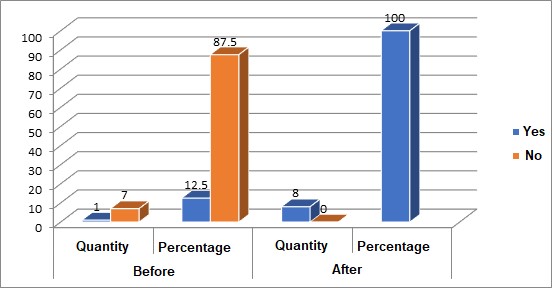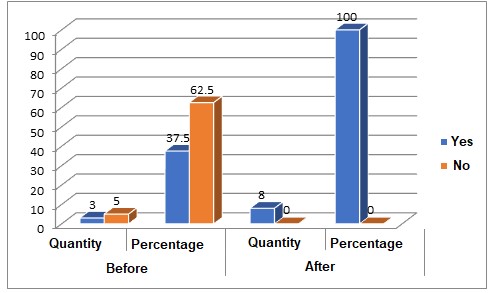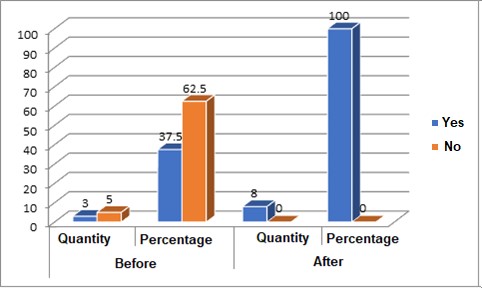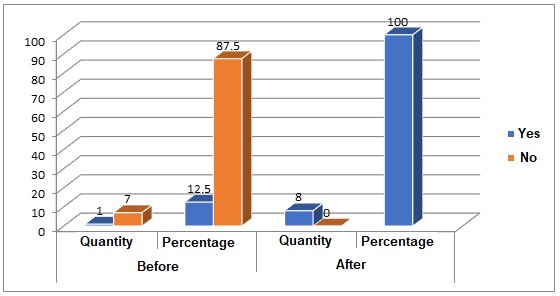Mi SciELO
Servicios Personalizados
Articulo
Indicadores
-
 Citado por SciELO
Citado por SciELO
Links relacionados
-
 Similares en
SciELO
Similares en
SciELO
Compartir
Ciencia y Deporte
versión On-line ISSN 2223-1773
Ciencia y Deporte vol.7 no.3 Camagüey sept.-dic. 2022 Epub 05-Sep-2022
http://dx.doi.org/10.34982/2223.1773.2022.v7.no3.005
Original article
A Methodological Strategy to Optimize the Snatch Technique in Junior Weightlifters
1Universidad Estatal de Guayaquil, Ecuador
Introduction:
This study deals with aspects associated with the knowledge of the snatch technique by junior weightlifters, considering the existence of methodological shortcomings that affect their performance.
Aim:
To design a methodological strategy to widen the existing knowledge of the snatch technique in junior weightlifters.
Materials and methods:
The research was based on theoretical methods. Analysis and assessment of information sources through the procedures of logic thinking (analysis-synthesis and induction-deduction; as well as empirical methods (survey and observation). The information was statistically processed.
Results:
The results from the practical validation of the proposal showed their pertinence and effectiveness, as there were significant differences in all the aspects evaluated during the research study.
Conclusions:
The methodological strategy to optimize the snatch technique of junior weightlifters contributed significantly to the teaching of this technique by the junior athlete coaches.
Key words: Strategy; sports strategy; knowledge; weightlifting
INTRODUCTION
Sports training is a pedagogic-educational process characterized by the organization of repeated physical exercise in sufficient quantities and intensity so that they stimulate the physiological process of body overcompensation increasingly, favoring the growth of physical, psychic, and tactical capacity of athletes to improve and confirm the test performance, according to Vittori, (1990) and Román, I. (2004).
Upon addressing practical issues in sports training and laying the scientific rationale for technical training, authors like Donskoi and Zatsiorski (1990) considered that biomechanics (generally) is the science of the mechanical movement laws applied to living systems, especially the locomotor apparatus of humans, whose study tackles the effectiveness of the motor action and its particularities.
To deepen the existing knowledge on the snatch technique in female weightlifters, it is necessary to understand the analysis of movement patterns, break it down and describe it by phases or periods that permit a more detailed analysis of the actions corresponding to movement, until the athlete becomes more familiar to the goal set. In weightlifting, it consists of lifting the greatest possible load without committing a foul.
Importantly, Fernández, A. L. A. (2019), conducted a biomechanical analysis of the snatch technique by segments, considering the trajectory of the bar, and suggested, according to Quevedo, M. A. C., Rodríguez, K. A. O., & Martínez, R. M. (2021) error correction during the training process, and possible injuries, (Giraldo Valencia, D. A., Martínez Guayazán, S. F., & Gutiérrez Velásquez, Y. F., 2021). Moreover, Rodríguez, K. A. O., et al. (2017) assessed the bio kinematic features observed during the snatch movement, to evaluate the behavior related to the quality of the technique application.
The kinematic analysis is one of the most commonly used biomechanical procedures to study the individual performance of weightlifters. The analysis of the kinematic structure of snatch focuses on the determination of the movements of different body segments when lifting, along with the different speeds and accelerations of the bar, to create, maintain, or modify movement structures. It offers greater objective information based on kinematic indicators that may be compared with already-established patterns or the performance of top athletes. The first serious studies about the technique are compiled in the manuals of the 1950s. Luchkin (1956); Bozkov (1959), and others cited by Herrera (2015), stressed the major role of the bar trajectory.
A particular athlete’s technique must be modeled depending on their traits. Copying blindly from another athlete’s technique may lead to irrational use of the strength possibilities, and at times may turn into an obstacle to sports development and optimization. Of all the known exercises performed by weightlifters, the greatest focus is on the techniques of competitive types: snatch and clean and jerk. From a pedagogic perspective, two methods are used to evaluate the weightlifting techniques.
One method records the movement of the technique through a sequence of photos. The other relies on studies that evaluate the individual possibilities of strength through photo sequences of the movements. This is usually expressed in association with the sports results and the strength possibilities of the corresponding muscle groups. It is measured during periods of inactivity to evaluate the effectiveness of weightlifting techniques. One of the most widely used methods is statistically-based comparisons, of the athlete’s strength possibilities according to their snatch and clean and jerk results. Guerreo, j. A. G., Blanco, l. A. B., Romero, c. A. M., & Aragón, o. A. Z. (2019).
In the snatch, the movement is divided into three phases, being the initial phase the grip and the initial positions of the athlete to hold the implement, as well as its exit, which entails specific movements that must be studied and trained correctly for higher performance in the mid and long terms. Due to the characteristics of the study sample, the technical movement of athletes belonging to La Libertad Sporting Club were assessed not only to establish the technical variables that encompass proper movement execution but also because of the lack of similar studies nationally, which might influence, directly or indirectly, the teachingeducational training of professionals associated with weightlifting and the technical enhancement and sports performance of the sample selected.
However, some shortcomings hinder the proper utilization of the snatch techniques by junior athletes. The analysis was directed to the methodological elements implemented by teachers, such as,
Inappropriate selection of methods (technical optimization) to deal with throughout the training.
Inadequate dosage for the junior category (no correspondence with the training loads during the technical optimization of snatch).
The error correction methods did not permit focusing on the specificities of snatch technical development.
Guevara, L. T., Figueredo, C. C., & Castellanos, Y. T. (2021) concluded that it was necessary to design a methodological category that favored the snatch technique; other authors such as Liquinchana, A., & Gabriela, M. (2021) determined the importance of considering the relation between snatch and the body posture, as well as the angular positions during lifting Pérez Orozco, M. A. (2020).
Accordingly, this paper aims to design a methodological strategy to improve the teaching of the snatch technique to junior weightlifters.
MATERIALS AND METHODS
This research was based on a non-experimental design, as it does not use the variables deliberately. The phenomena were studied as they occurred in context, describing or analyzing the variables and their possible relations, without causing any external change during the research. (Valdés, H., et al., 1987).
The design included a longitudinal study (to unveil and understand the change processes in time) since the instruments used were applied in two segments mediated over a 6-month period.
Population and sample
A number of 8 weightlifting coaches from La Libertad Sporting Club were included in the study (100%). All of them shared more than 10 years of experience in weightlifting training and held every possible university degree. Methods and techniques
Theoretical methods:
Analytical-synthetic: Greater emphasis was placed on the assessment of the necessary information gathered to design the theoretical-reference frame and to determine the characteristics of the technique used for the snatch.
Inductive-deductive: It contributed to the definition of the research problem based on the diagnostic results, and to determining the characteristics of the technical execution to suggest possible solutions to the issues found.
Empirical methods
Non-participatory scientific observation: It was included in the study to know the utilization of the methodological tools of the teachers during the training, and the methodology used during the training sessions, coinciding with the indicators stated in the survey.
The surveyed teachers provided their opinions on the utilization and execution of the snatch technique, the dosage, and error correction throughout the teaching of junior weightlifters.
Statistical-mathematical methods
Descriptive statistics were used, particularly the relative and absolute frequency distribution, with the analysis of the results of the questions in the survey.
Besides, inferential statistics were used, namely, the non-parametric McNemar test, which helped corroborate the validity of the results. The significance level was set to 0.05 or lower.
The methodological strategy
The purpose of the strategy was to broaden the existing knowledge of the snatch technique in junior weightlifters (Table 1).
Table 1. - Design of a methodological strategy to broaden the existing knowledge on the snatch technique in junior weightlifters
| stages | Actions |
| Diagnosis | Selection of instruments to be used Preparation of the personnel that will apply them Carry out a pilot apply the instruments appreciate the results |
| Stage 2 planning | Selection of the ways or means to be used to improve knowledge about the snatch technique in weightlifters. Conduct preparation workshops Teach training courses hold a seminar integrator |
| Stage 3 application | Develop implementation plan Manage resources and means |
| Stage 4 Evaluation | Selection of indicators to measure Process the data obtained Prepare the analysis of the results Discuss the results with the teachers |
RESULTS AND DISCUSSION
In this section, the authors analyzed the main results achieved in the study. At first, descriptively, then inferential; the interpretation of the study is given below:
Question 1. Select the training methods according to the characteristics of the junior category (Figure 1).
As shown in the graphic, at first, the teachers had little knowledge of the proper training method selection for the junior category. Only 1 (12.5%) evidenced knowledge. The other seven (87.5%) manifested that they did not know.
However, after the implementation of the strategy, significant transformations were observed. All the teachers remarked that they considered the training methods in keeping with the junior characteristics.
Question 2. Do you conduct methodological work to improve the snatch technique in junior weightlifters? (Figure 2).
Graph 2 shows the results of question No. 2 of the survey to teachers. Before implementing the strategy, there were shortcomings in the methodological work regarding necessary improvements to the snatch technique of junior weightlifters. Only two (25%) noted that they dealt with this topic in the methodological work. The other 6 (75%) said the opposite.
Upon the implementation of the strategy and the corresponding research cut, seven teachers (87.5%) manifested that they dealt with this topic in the methodological work, whereas only one (12.5%) said the opposite.
Question No. 3. Are the repetitions arranged according to the junior category characteristics? (Figure 3).
An assessment of the results of graph No. 3 showed that before implementing the strategy, most teachers said that they did not use the repetitions sparingly, depending on the junior category characteristics (Graph 3). However, following the implementation of the strategy, there was a significant change (100% claimed to use it).
Question No. 4. Do you correct the snatch errors made by junior athletes? (Figure 4).
An assessment of the results of graph No. 4 showed that before implementing the strategy most teachers said that they did not correct errors properly. However, following the implementation of the strategy, there was a significant change (100% claimed to use it).
Question No. 5. Do you place the technical preparation at the beginning of the training session? (Figure 5).
As shown in graph 5, at the first moment of the research, most coaches did not place the technical preparation at the beginning of the training session, only one did (12.5%). The other seven (87.5%) expressed a negative response.
However, upon the implementation of the strategy, significant changes were observed, as all the coaches said that they placed it at the beginning of the training session.
Results of inferential statistics (Table 2).
Table 2. - Results of the non-parametric McNemar test
| Initial question 1 and final question 1 | Initial question 2 and final question 2 | Initial question 3 and final question 3 | Initial question 4 and final question 4 | Initial question 5 and final question 5 | |
| N | 8 | 8 | 8 | 8 | 8 |
| Chi-square | 24.018 | 30.016 | 49.016 | 49.016 | 24.018 |
| Asymptotic sig. | .000 | .000 | .000 | .000 | .000 |
Source: Windows SPSS 20
An assessment of the McNemar test showed that the comparison of all the questions in the survey applied produced a significant difference p 0.00, confirming the validity of the results achieved in this research paper.
CONCLUSIONS
The study of the theoretical rationale that characterized the knowledge of the snatch techniques observed in female junior weightlifters revealed the need for novel ways of preparing teachers of this sport to improve the performance of their athletes.
Based on the interpretation of the collected data, and upon the implementation of descriptive and inferential statistics, it was concluded that the methodological strategy to optimize the snatch technique of junior weightlifters contributed significantly to the teaching of this technique by the junior athlete coaches.
REFERENCIAS BIBLIOGRÁFICAS
Corzo, A. H. (2015). La técnica en el ejercicio clin o cargada, los errores técnicos detectados en el halterofilismo, bodybuilding y crossfit. Causas, consecuencias y corrección. Lecturas: Educación física y deportes, (203), 9. https://efdeportes.com/efd203/errores-tecnicos-detectados-en-elcrossfit.htm [ Links ]
Fernández, A. L. A. (2019). Análisis biomecánico de la división por partes de la técnica de arranque. Ciencia y Actividad Física, 5(2), 58-67. http://revistaciaf.uclv.edu.cu/index.php/CIAF/article/view/88 [ Links ]
Guerreo, j. A. G., Blanco, l. A. B., Romero, c. A. M., & Aragón, o. A. Z. (2019). Análisis biomecánico y rendimiento deportivo de los levantadores de pesas de la universidad del atlántico. Revista educación física, deporte y salud, 2(3), 1-20. http://investigaciones.uniatlantico.edu.co/revistas/index.php/REDFIDS/articl e/view/3156 [ Links ]
Giraldo Valencia, D. A., Martínez Guayazán, S. F., & Gutiérrez Velásquez, Y. F. (2021). Prevalencia de lesiones en deportistas de halterofilia en Colombia. https://repositorio.ibero.edu.co/bitstream/handle/001/1171/Prevalencia%20de%20lesiones%20en%20deportistas%20de%20halterofilia%20en%20Colombia.pdf;jsessionid=A2937024BE275384362B735078032B5A?sequence=1 [ Links ]
Guevara, L. T., Figueredo, C. C., & Castellanos, Y. T. (2021). La preparación técnico-física, prioridad en el entrenamiento de los pesistas principiantes (Revisión). Revista científica Olimpia, 18(1), 558-567. https://revistas.udg.co.cu/index.php/olimpia/article/view/2343 [ Links ]
Quevedo, M. A. C., Rodríguez, K. A. O., & Martínez, R. M. (2021). Caracterización cualitativa de la ejecución del press de banca en una atleta del equipo Granma en situación de discapacidad (Original). Revista científica Olimpia, 18(1), 641-651. https://revistas.udg.co.cu/index.php/olimpia/article/view/2428 [ Links ]
Rodríguez, K. A. O., Zoquez, A. G., Corrales, R. Z., & Manzo, Y. G. (2017). Análisis biocinemático de la ejecución del arranque en levantadoras de pesas escolares de Granma (original). Olimpia: Publicación científica de la facultad de cultura física de la Universidad de Granma, 14(42), 62-74. https://revistas.udg.co.cu/index.php/olimpia/article/view/1274 [ Links ]
Román Suárez, I. (2004). Giga fuerza. Editorial Deportes. Ciudad de La Habana. [ Links ]
Valdés, H., Estévez, M., Arroyo, M., & Peralta, E. (1987). Introducción a la investigación científica aplicada a la educación física y el deporte. Habana: Editorial Pueblo y Educación. https://books.google.com.cu/books/about/Introducci%C3%B3n_a_la_investi gaci%C3%B3n_cient.html?id=ZDw3PwAACAAJ&redir_esc=y [ Links ]
Vittori, C. (1990). El entrenamiento de la fuerza para el sprint. RED: Revista de entrenamiento deportivo= Journal of Sports Training, 4(3), 2-8. https://dialnet.unirioja.es/servlet/articulo?codigo=3706404 [ Links ]
Zatsiorski, V., & Donskoi, D. (1990). Biomecánica de los ejercicios físicos. 1ª reimpresión. La Habana: Pueblo y Educación. https://www.abebooks.com/9785050012791/Biomec%C3%A1nicaejercicios-f%C3%ADsicos-Manual-5050012791/plp [ Links ]
Received: April 30, 2022; Accepted: May 20, 2022











 texto en
texto en 







